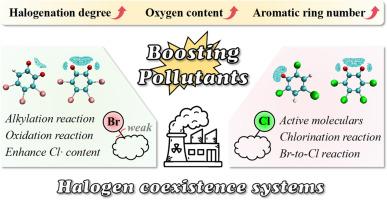卤素共存促进污染物形成的自由基机制
IF 6.3
2区 环境科学与生态学
Q1 ENVIRONMENTAL SCIENCES
引用次数: 0
摘要
卤素在工业热过程中很常见,可以诱导形成有毒的有机污染物。目前,共存卤素对有毒污染物形成的具体影响尚不清楚。在本研究中,我们发现了卤素对热过程中有机污染物形成的促进作用。采用原位电子顺磁共振波谱法对有机污染物热过程中的有机自由基中间体进行了判别。纯含氯反应体系主要诱导高氯化苯氧自由基的形成,而纯含溴反应体系主要诱导半醌自由基的形成。结果为卤素共存促进污染物形成的分子机制提供了明确的证据。共存的卤素使得反应更加复杂。溴原子自由基(Br·)可以增强活性氯原子自由基(Cl·)的水平,从而(1)促进高氯化有机自由基和有毒污染物的形成,(2)激活多环芳烃分子,促进后续的环生长,(3)加速氧化反应。结合有机自由基中间体的鉴定和产物的特点,阐明了卤素在热相关过程中对有机污染物形成的详细机理,有助于在广泛存在的溴氯共存反应体系中对卤素的有效控制。本文章由计算机程序翻译,如有差异,请以英文原文为准。

Free radical mechanisms of halogen coexistence promoting pollutants formation
Halogens are common in industrial thermal processes and can induce formation of toxic organic pollutants. Currently, the specific effects of coexisting halogens on toxic pollutant formation are unclear. In this study, we found the boosting effects of halogens on organic pollutants formation during thermal processes. In situ electron paramagnetic resonance spectroscopy was used to distinguish the organic free radical intermediates of organic pollutants during thermal processes. The pure chlorine-containing reaction system dominantly induce the formation of highly chlorinated phenoxy radicals, whereas the pure bromine-containing reaction system induce the formation of semiquinone radicals. The results provide clear evidence for the molecular mechanisms by which halogen coexistence boosts pollutants formation. Coexisting halogens made the reactions much more complex. Bromine atom radicals (Br·) can enhance the level of active chlorine atoms radicals (Cl·), then (1) facilitating highly chlorinated organic radicals and toxic pollutants formation, (2) activating polycyclic aromatic hydrocarbons molecules for subsequent ring growth and (3) accelerating oxidation reactions. Combining the identification of organic free radical intermediates and characteristics of products, detailed mechanisms of halogens on the formations of organic pollutants during thermal-related processes were clarified, which can be helpful for their efficient control in the widespread bromines and chlorines co-existence reaction system.
求助全文
通过发布文献求助,成功后即可免费获取论文全文。
去求助
来源期刊

Journal of Environmental Sciences-china
环境科学-环境科学
CiteScore
13.70
自引率
0.00%
发文量
6354
审稿时长
2.6 months
期刊介绍:
The Journal of Environmental Sciences is an international journal started in 1989. The journal is devoted to publish original, peer-reviewed research papers on main aspects of environmental sciences, such as environmental chemistry, environmental biology, ecology, geosciences and environmental physics. Appropriate subjects include basic and applied research on atmospheric, terrestrial and aquatic environments, pollution control and abatement technology, conservation of natural resources, environmental health and toxicology. Announcements of international environmental science meetings and other recent information are also included.
 求助内容:
求助内容: 应助结果提醒方式:
应助结果提醒方式:


